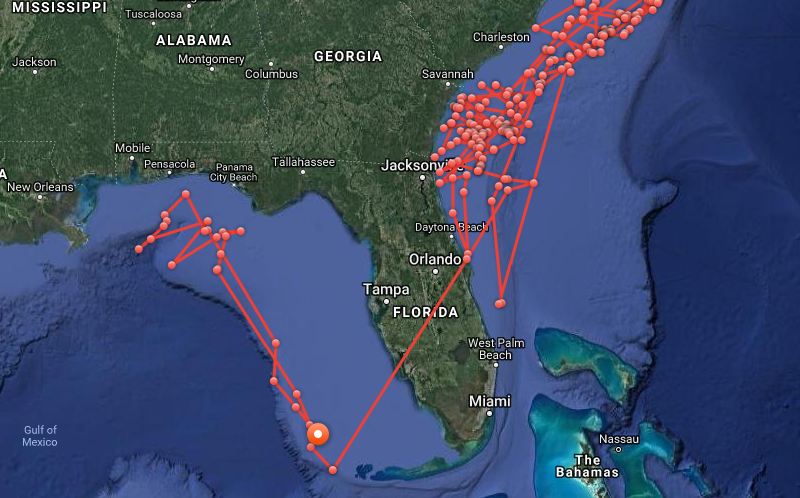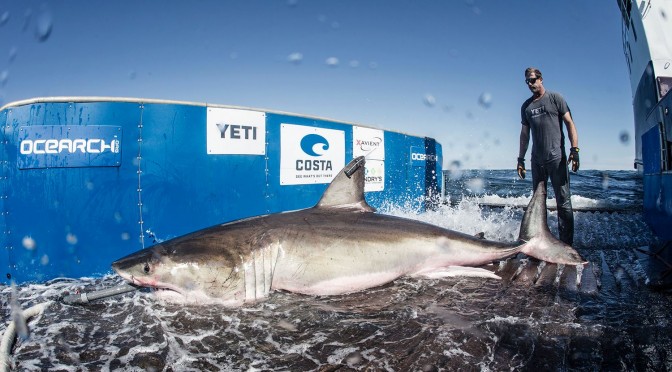It seems that every year we hear some “news” about how there are white sharks in the Gulf of Mexico. It’s as if the mere existence of these sharks in the Gulf is so profoundly unusual that it merits our attention. Well, it’s happening again. Two sharks that go by the name of Hilton and Yeti have been picked up by the satellite trackers attached to their dorsal region over the past couple weeks. Hilton first, in late April, then Yeti just yesterday. It’s worth mentioning that there are literally hundreds if not thousands of local sharks in your saltwater area ranging from all different sizes. 12 foot long Hilton is pictured in the featured image aboard the water platform attached to the Ocearch research vessel during his tagging. It’s actually actually quite commonplace to hear about white sharks in the gulf. Still, the recent ping from Hilton and Yeti’s satellite tags is a great opportunity to talk a little bit about sharks and their movements.
Let’s start with an analogy a fisherman once said. He was using this analogy to explain how to catch fish. It’s also a good way to understand how to find them. He said, fish are like people. Think about this, what you want to eat today may be a turkey sandwich, but tomorrow you might want a steak, and the next day maybe a salad. When talking about the food they eat, they may not always want the same thing from the same place. This subjective preference for different foods may dictate how these fish move. It certainly seems like a possibility, and definitely something the experts consider when trying make guesses about how and why these fish are moving. Food is a major driver for white shark behavior, and shark behavior in general for that matter. Food along the very fishy panhandle region of the continental shelf is a common source of sustinence for white sharks (see Hilton movement map below). Since being tagged by Ocearch Hilton has traveled 9929.312 miles between March 03, 2017 and April 2018.

When thinking locally about migratory shark behavior the local topography comes into consideration. We have an area behind Honeymoon Island State Park once described to me by a close friend as Shark Alley. It’s a trough that runs along the back side of the island that’s literally loaded with sharks. This deeper channel along the grass flat is a great transportation route for small and large sharks alike. On any given day you might spot a larger shark traveling through shark alley, and since this route is one of the more ideal routes, it’s more common to see the fish along it. Ideal routes to food, to move with the tides, or simply weather based movements are an obvious predictor of shark migration behaviors.
Questions one might ask as a researcher, questions undoubtedly left unanswered fall into a location and movement line of questioning. Do sharks have predictable patterns that they fall into? Do they have memories and are they impacted by them in a way that makes them more or less likely to return to a previous location? Some people think many fish travel along the same routes and to the same places year after year. Some people think fish just move as they wish. Do some species have preferences for certain regions of the gulf and why? Do they all have the same patterns of behaviors? Human behavior is so variable, are any fish like us? Biologists have mentioned that Dolphins are the only animals that engage in recreational intercourse. Do sharks exhibit unique human-like behaviors like this?
Correlational data are gathered and collated for many fish. It’s actually the only source of data for this kind of research. Problematic is the reality of the data, its depth and breadth. It’s hard to know exactly how many white sharks have been moving through the gulf. So we’ve got satellite tags on two of the ones in the gulf, but there could be hundreds more. We also have a hard time saying with certainty anything about why these creatures do what they do. If only they were like humans and we could just ask them, and try to trust that what they’re saying is accurate at least from their perspective. Unfortunately, sharks may be just as unpredictable and unreliable as humans.
You can read more about what Ocearch is doing on their website, watch videos, see shark info, and other related information on Ocearch.org.





